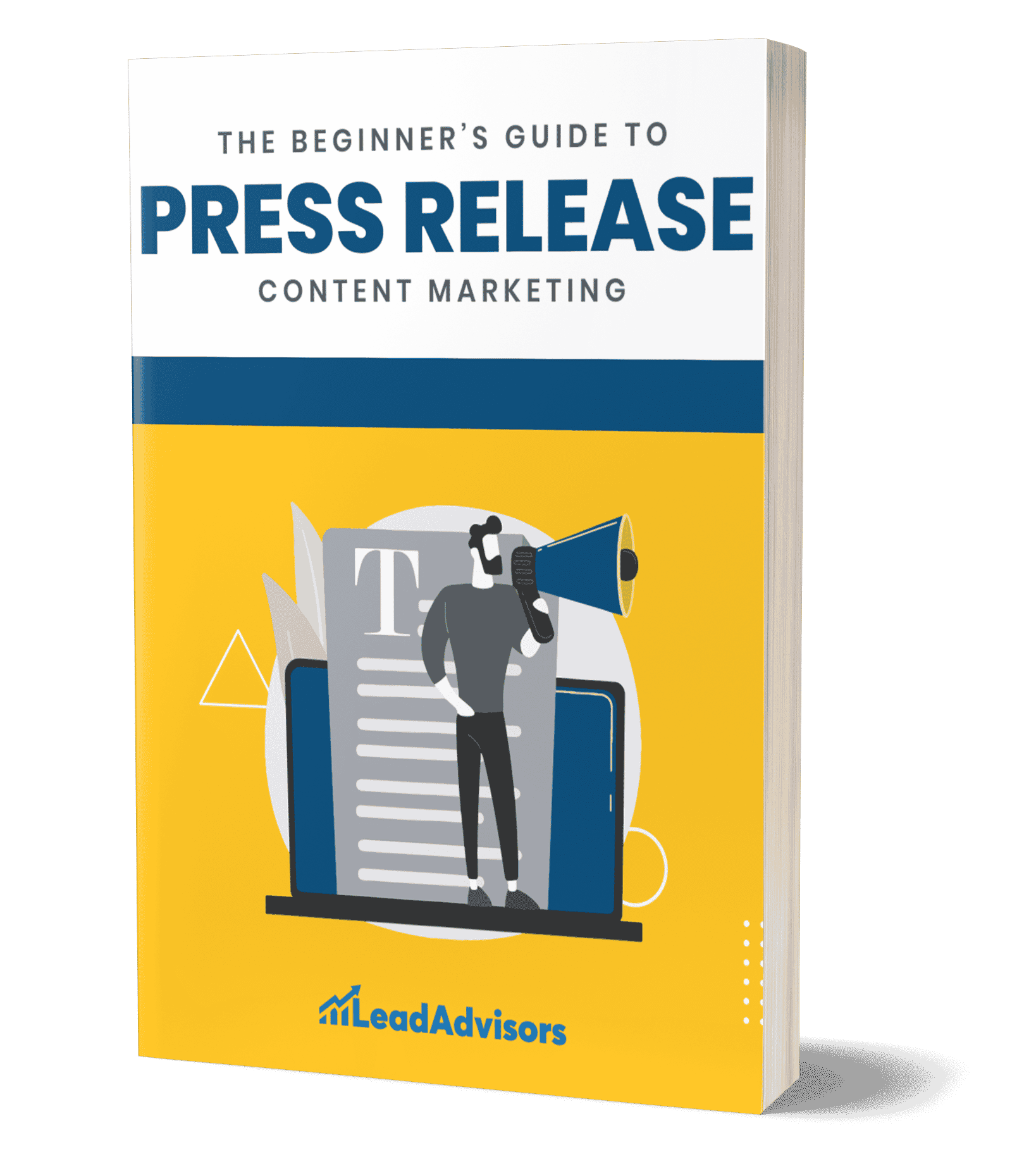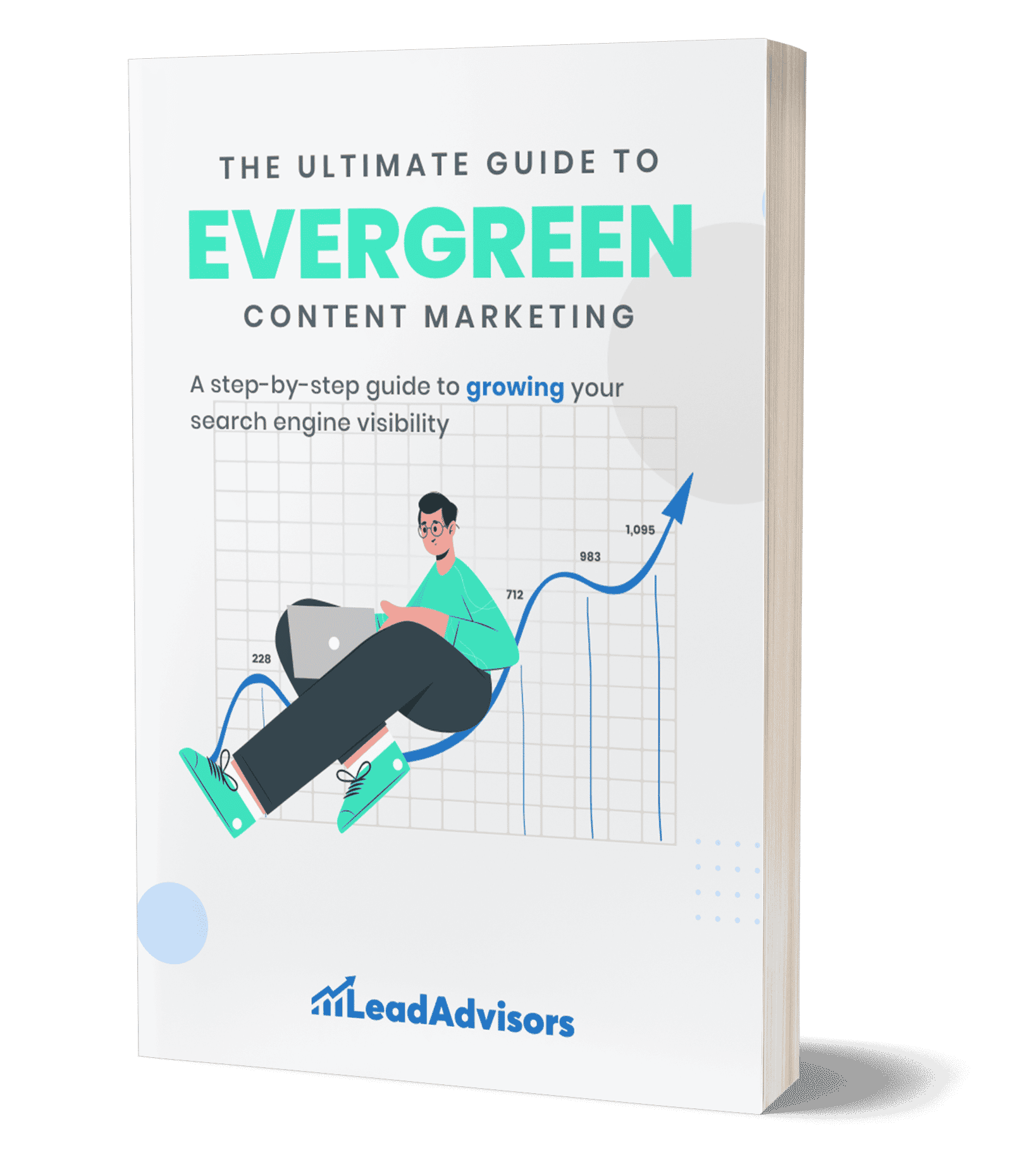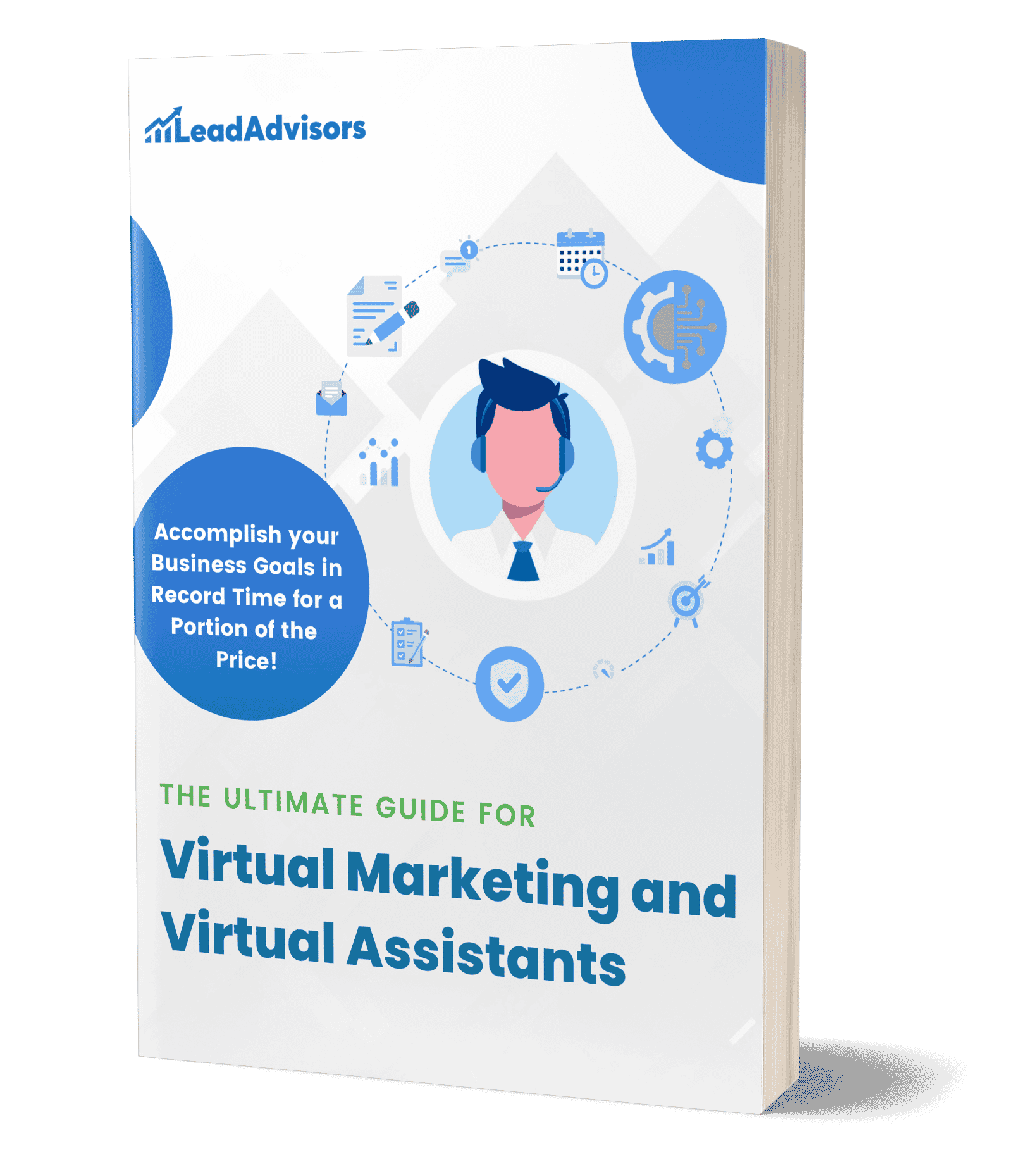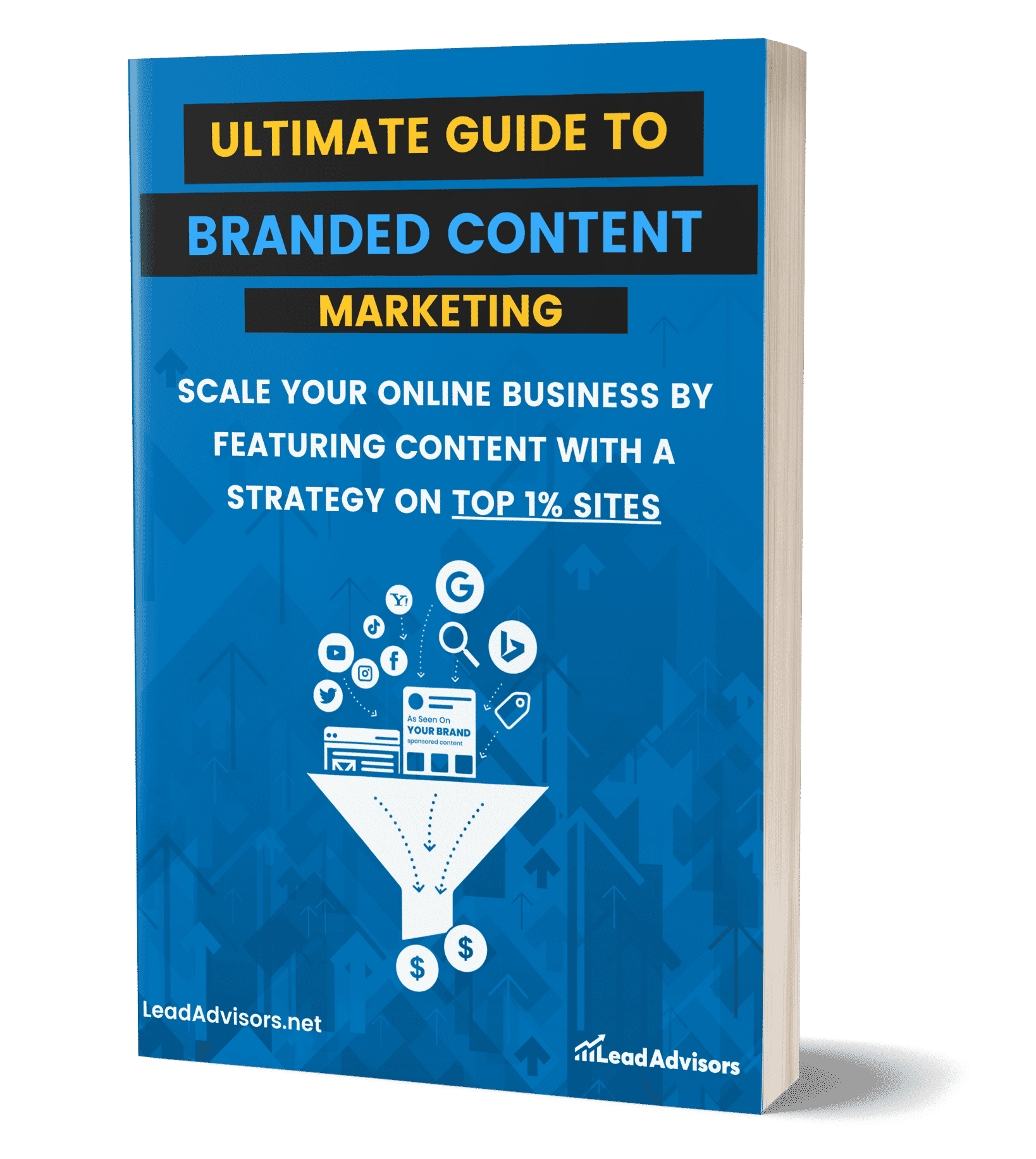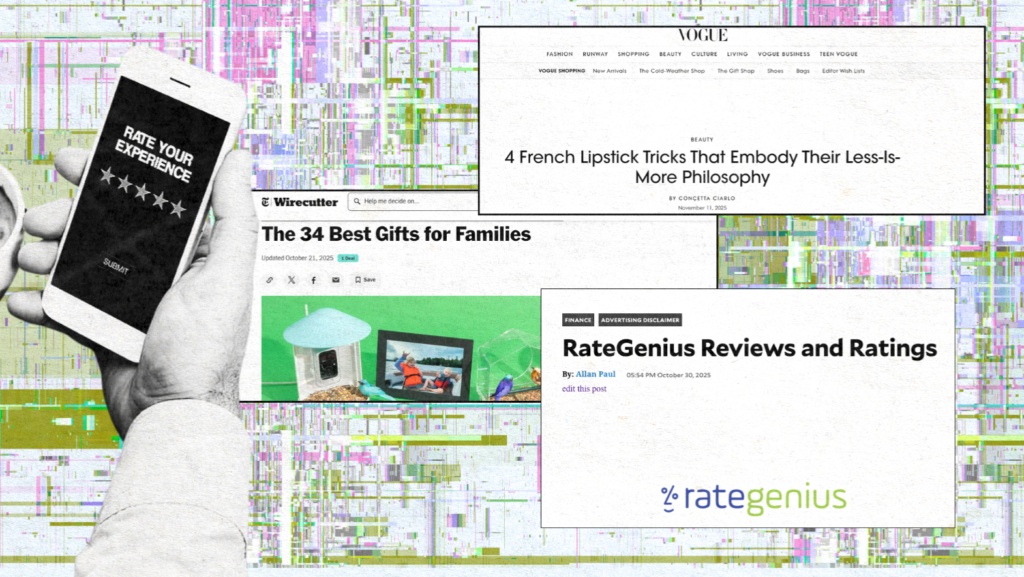Several agencies lose customers even before the commencement of work, and not due to poor SEO services. The problem? A weak SEO proposal. It is difficult to demonstrate to the prospects why you are the right partner to meet their search engine optimization requirements without a clear and convincing proposal.
And this is where this guide comes in. We shall deconstruct an SEO proposal, its importance, and the specifics of how to write one that would help you make more deals. You will learn to define goals, strategies, and deliverables in a manner that will help you gain trust and make your agency stand out.
Due to the time-consuming nature of writing proposals from scratch, we are providing a free template of an SEO proposal that you can tailor now. As a beginner in pitching clients or simply looking to make the process more efficient, this guide will provide you with everything you need to create a professional SEO proposal template for 2025.
TL;DR
SEO proposals help agencies win clients by showing clear goals, strategies, and ROI.
A strong proposal builds trust and turns pitches into signed deals.
Customization and clarity matter more than fancy design.
Avoid jargon, vague promises, and weak calls to action.
Use templates and tools to save time and keep proposals professional.
Goal: make every proposal clear, credible, and conversion-focused.
What Is an SEO Proposal?
Your proposal is an SEO proposal, a document that details your pitch to potential customers. It is the roadmap that you offer to potential customers, explaining how your marketing agency can approach the particular SEO issues faced by their clients.
It also details the search engine optimization plan, cost, and deliverables in a manner that clearly demonstrates why you are the right choice to assist them with their search engine optimization requirements.
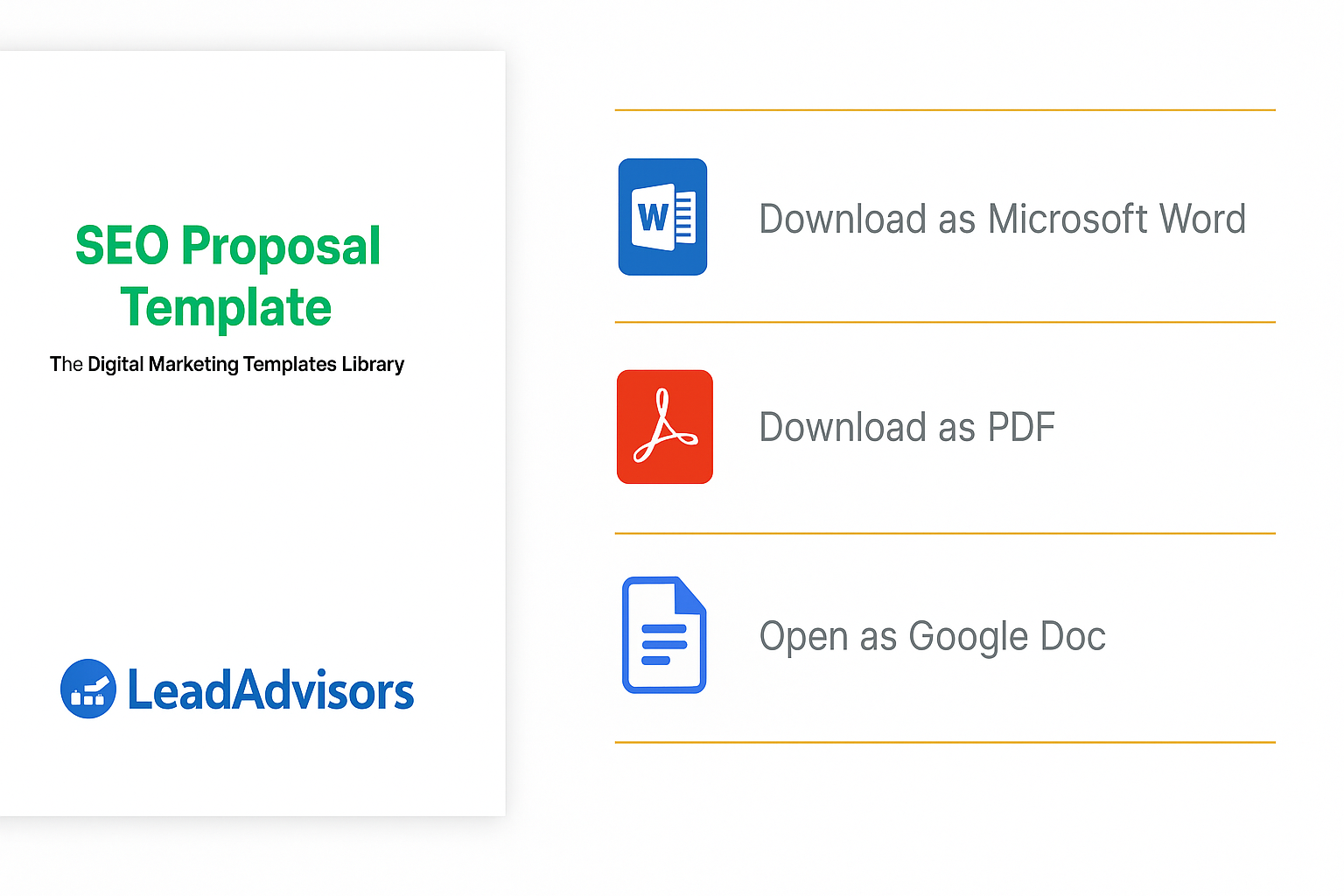
Here’s what an SEO proposal usually includes:
- A plan of your SEO services (audits, targeting of keywords, link building, content, etc.).
- The accomplishments you have made with earlier customers.
- An obvious strategy outlining how you will increase their visibility in the search engine rankings.
- Planned schedule, budget, and performance.
Proposal vs. Contract
One thing many guides skip is the difference between a proposal and a contract:
- Proposal → persuasive document, designed to win trust and secure a “yes.”
- Contract → legally binding, signed after the proposal is accepted.
Businesses, whether local or national, virtually always want to see a proposal first. It will help them understand how you approach things, whether that’s a local audit of your SEO or a comprehensive campaign.
A practical and successful SEO proposal will give clients hope of success. This is the reason why all agencies must have a template of the SEO proposal ready to use. To simplify it even further, we have provided a template for a free SEO proposal later in this guide, so you can fill in the information and begin pitching like professionals.
Why SEO Proposals Matter for Closing Clients
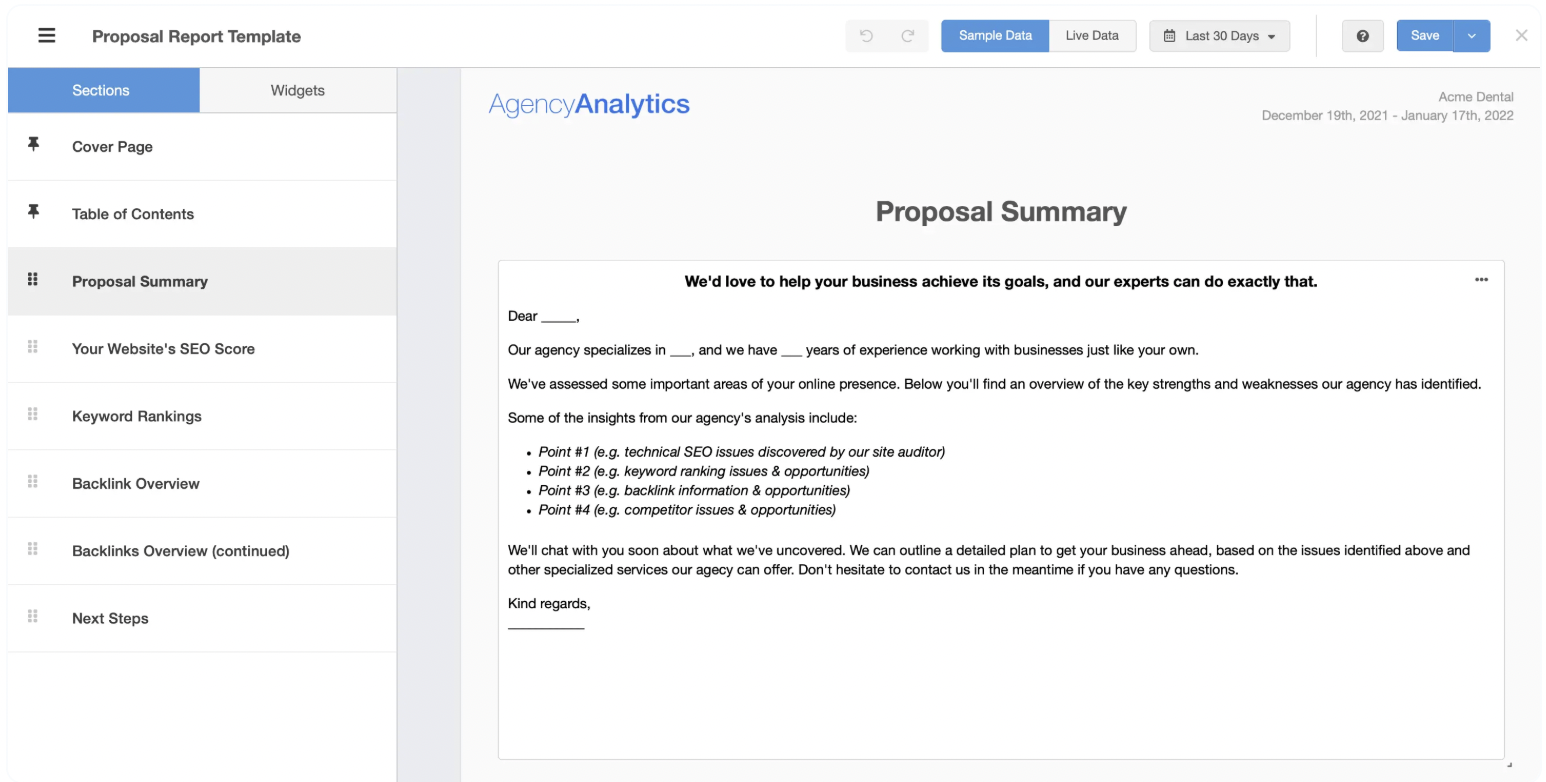
A proposal is more than just a piece of paper; it is the transition from a sales pitch to a deal. For many SEO agencies, it is about how to write an SEO proposal with confidence and clarity, so that the difference between losing a lead and securing a partnership becomes clear over time.
Here’s how proposals fit into the sales cycle:
- Display experience → Establish that you are familiar with how to manage everything, including on-page SEO and link building.
- Develop trust – An optimized, successful proposal in SEO makes your agency appear to be organized and reliable.
- Make ROI real to life → Prospects desire to identify how your SEO work will drive up organic search traffic and enhance the online presence of their client.
From a client’s perspective, proposals matter because:
- They lower perceived risk. A clear project of the SEO gives them assurance that they will not be left in the dark.
- They prove credibility. Even the local SEO campaign will be more credible when planned on paper.
- They set expectations early. A sound proposal avoids mix-up in the goals, deliverables, and schedules.
In a nutshell, you are not only selling services to your prospective customer when you have the ability to create an SEO proposal that links the dots and makes sense to your potential customer.
This is why we offer a free seo proposal template that you can use in your next pitch. It will help you craft proposals that seal deals and provide your agency with a professional edge.
Key Elements Every SEO Proposal Should Include
Every SEO expert knows that the difference between landing a deal and losing it often comes down to presentation. A good SEO proposal not only highlights your skills but also reassures a potential client that you can deliver results.
Whether you’re pitching local SEO, ecommerce, or national campaigns, these are the core sections that make proposals work.
1. Executive Summary & Introduction
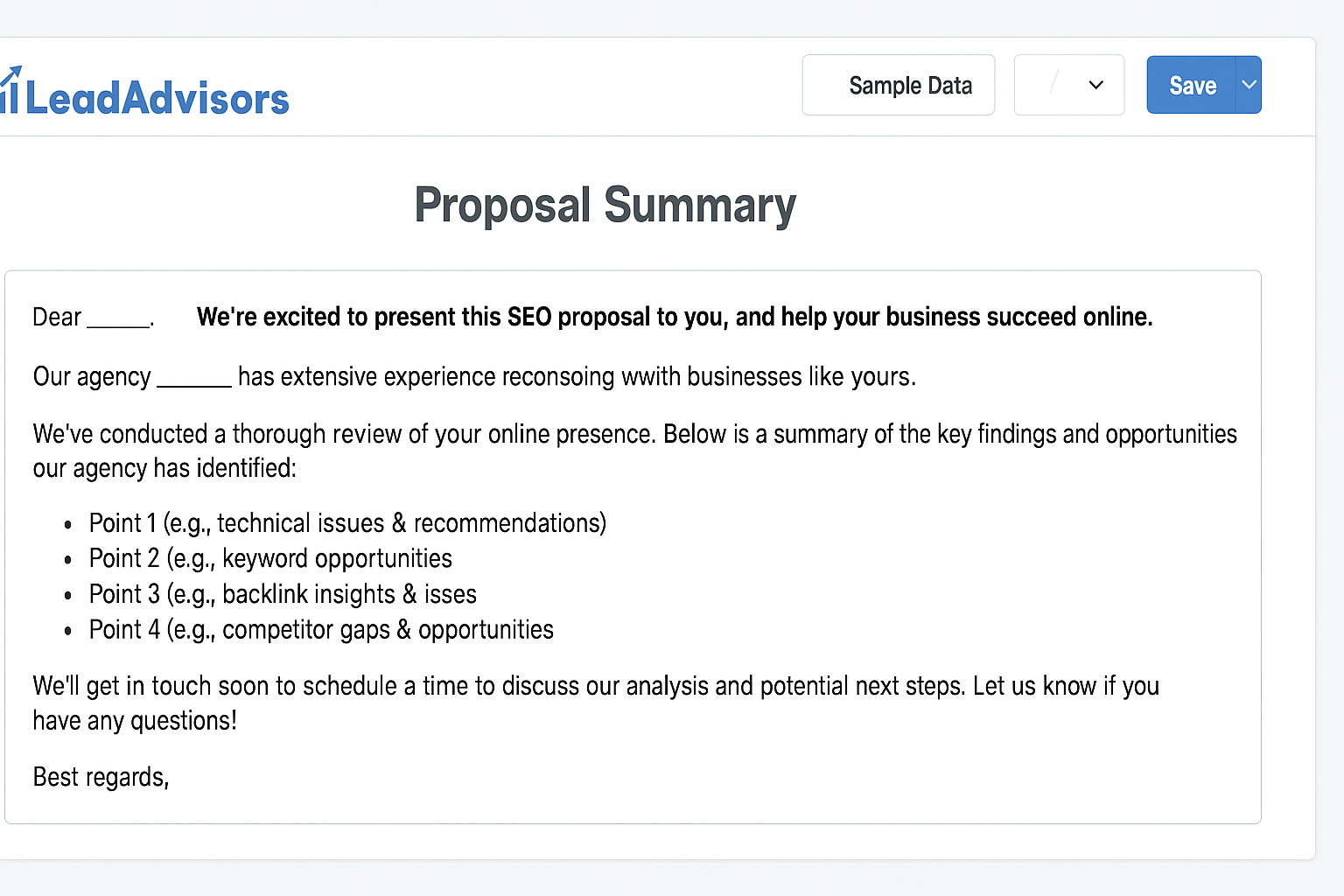
This is the hook of your proposal. Think of it as the executive elevator pitch for busy decision-makers.
- Personalize everything → Don’t use a cookie-cutter intro. Call out the client’s online presence and the pain points they’ve shared with you.
- Focus on outcomes → Instead of bragging about your process, highlight how your SEO work will lead to more visibility, more traffic, and more revenue.
- Speak their language → Remember, many business owners aren’t tech-savvy. Skip jargon and keep it practical.
Example: “Our SEO strategy will help you capture more qualified leads by improving your rankings for high-intent keywords and expanding your local visibility.”
2. SEO Insights & Current Situation
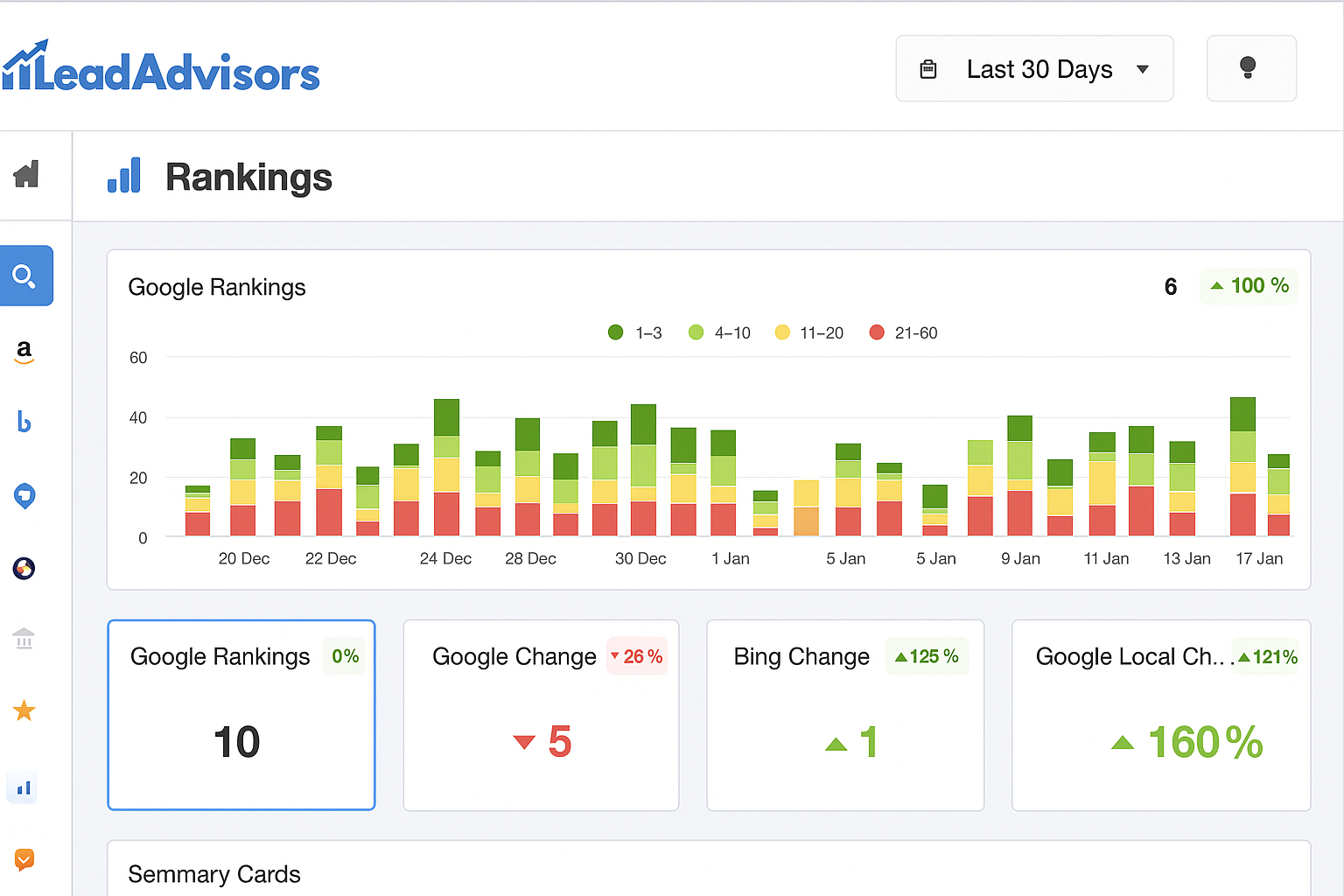
Before you pitch solutions, show the client what you’ve discovered. This is where mini-audits shine.
- Rankings snapshot → Show where their main keywords stand today.
- Traffic analysis → Highlight gaps where competitors are stealing clicks.
- Competitor benchmarks → Brief comparisons of authority, backlinks, and content depth.
- Local visibility → For local SEO, include a quick local SEO audit (e.g., citations, Google Business Profile health, NAP consistency).
When you lead with insights, the client sees you’ve done the homework and aren’t just selling generic SEO services.
3. Clear SEO Goals & Objectives
A good SEO proposal always ties tactics to outcomes. Use the SMART framework to set SEO project expectations:
- Specific → “Increase leads from organic traffic by 20%.”
- Measurable → “Rank in the top 3 for at least 5 target keywords.”
- Achievable → Avoid over-promising in competitive niches.
- Relevant → Tie goals directly to the client’s revenue streams.
- Time-bound → Outline short-term (90 days) vs. long-term (12 months) milestones.
This reassures potential clients that your plan is grounded and results-focused.
4. Proposed Strategy & Deliverables
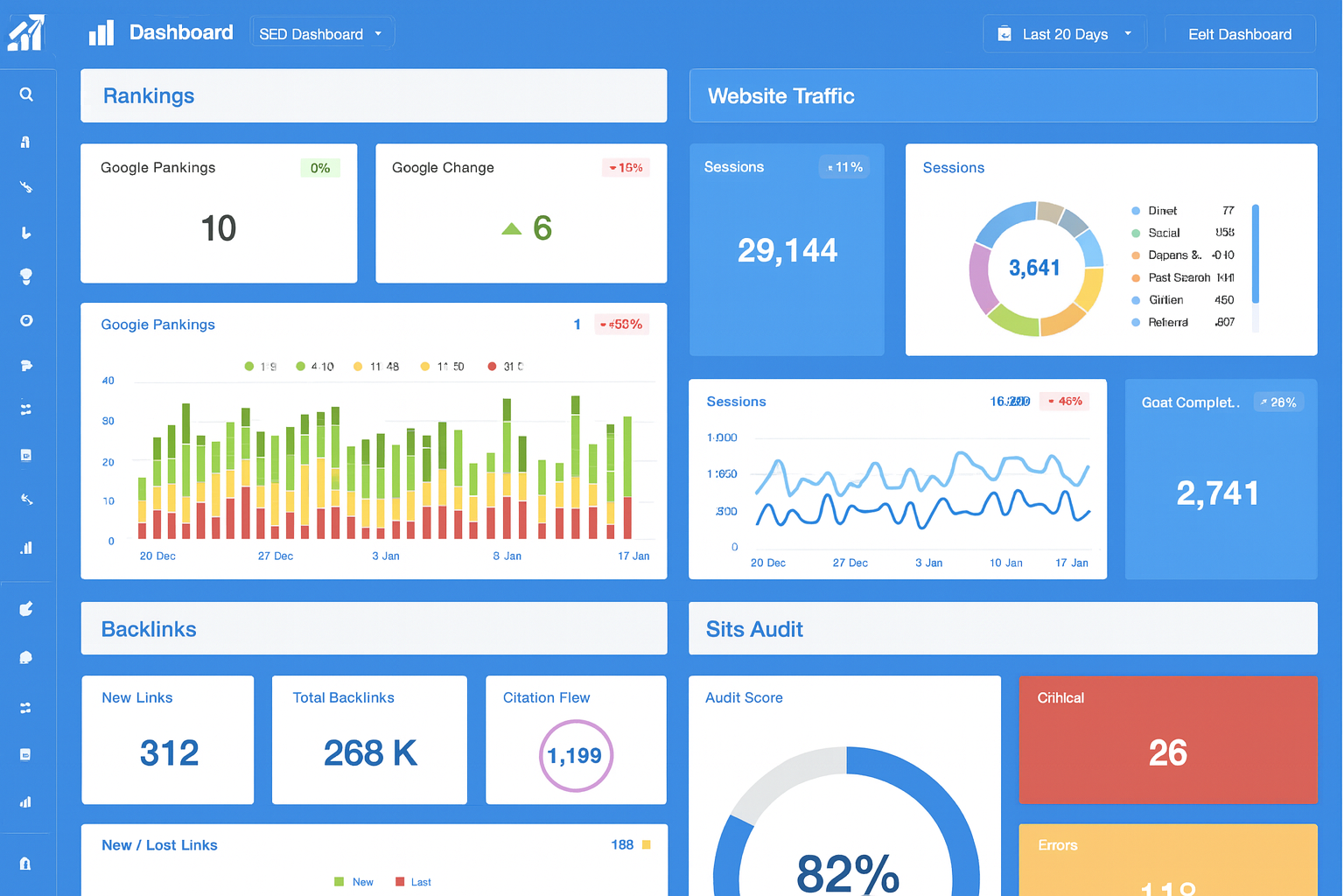
This section is where your expertise shines. Break down the SEO efforts across all key areas:
- On page SEO → technical audits, site speed fixes, metadata optimization, internal linking improvements.
- Off-page SEO → link building<span style=”font-weight: 400;”> campaigns, digital PR, citation management.
- Content → keyword-driven blogs, service page optimization, content clusters.
- Technical SEO → fixing crawl errors, mobile optimization, schema markup.
Deliverables should be clear and tangible. For example:
- 4 optimized blog posts/month.
- 20 high-quality backlinks per quarter.
- Full on page SEO audit in the first 30 days.
By breaking it down like this, the potential client sees exactly what they’re paying for.
5. Project Timeline & Milestones
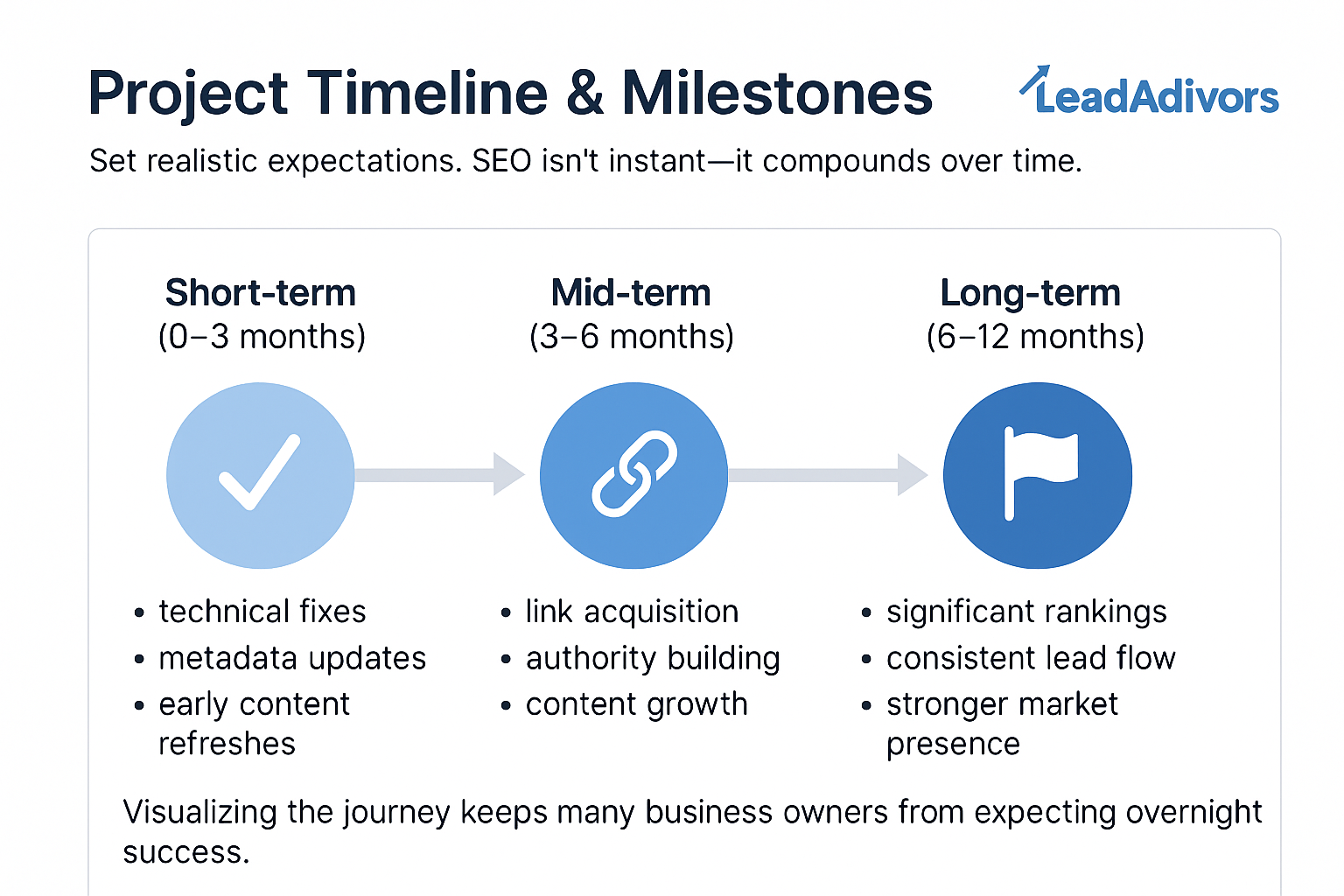
Set realistic expectations. SEO isn’t instant—it compounds over time.
- Short-term wins (0–3 months): technical fixes, metadata updates, early content refreshes.
- Mid-term (3–6 months): link acquisition, authority building, content growth.
- Long-term (6–12 months): significant rankings, consistent lead flow, stronger market presence.
Visualizing the journey keeps many business owners from expecting overnight success.
6. Investment & Pricing Options
Money talks. Be upfront and flexible in presenting pricing structures.
- Retainer model → Best for ongoing work and consistent results.
- Hourly rate → Works well for limited-scope or consultation-style projects.
- Package options → Predefined bundles (e.g., starter, growth, enterprise) that give potential clients a clear choice.
Position the cost as an investment in growth. For example: “This plan is designed to increase qualified leads, which offsets the monthly investment within 4–6 months.”
7. Expected ROI & Forecasts
Clients rarely buy “SEO tasks”—they buy results. Make ROI as concrete as possible.
- Traffic growth forecasts → Show projected increases in organic search traffic.
- Revenue impact → Translate rankings into leads and sales estimates.
- Visuals matter → Use charts, graphs, and growth curves to make data feel tangible.
If you can, pull examples from previous clients where similar SEO efforts led to measurable wins. That social proof builds instant credibility.
8. Call to Action & Next Steps
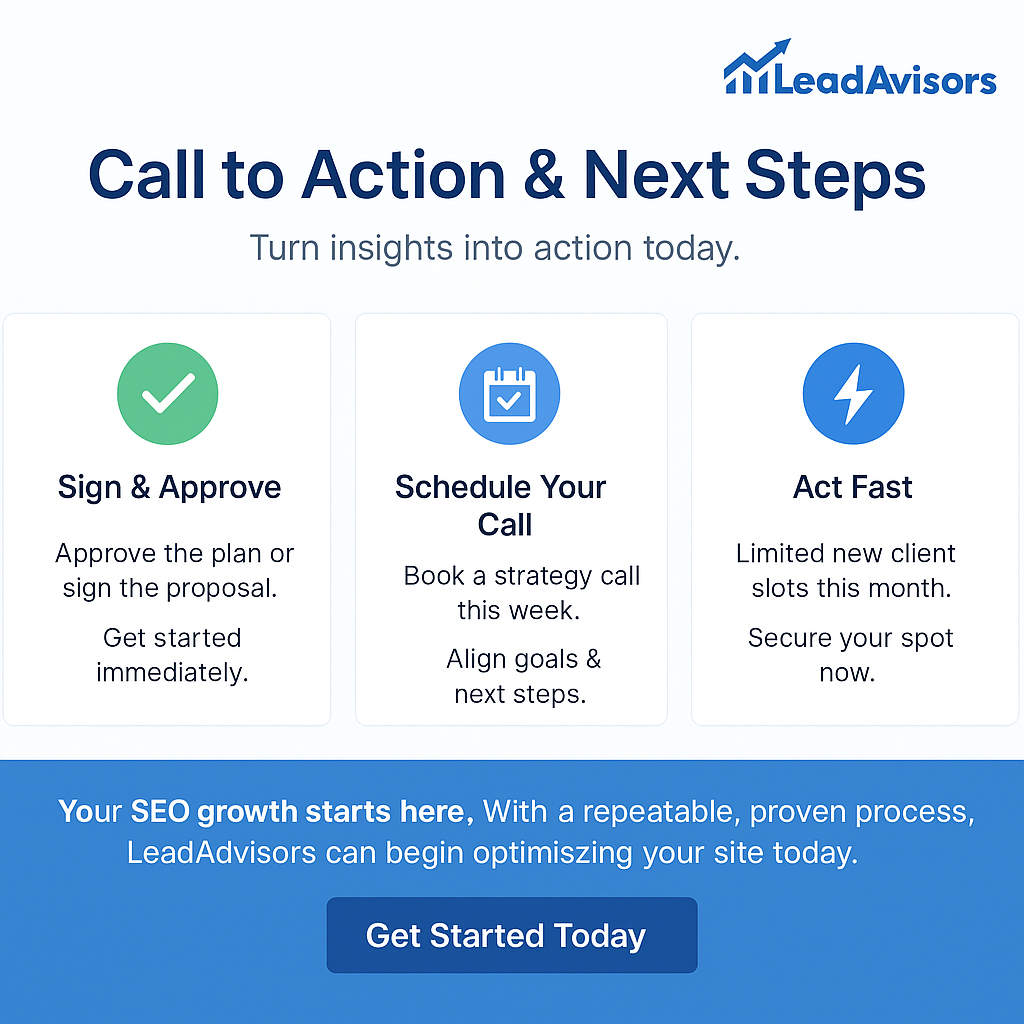
End strong with a direct, confident CTA. Don’t just leave them hanging.
- Encourage them to sign the proposal or approve the plan.
- Offer to schedule a strategy call within the week.
- Reassure them that your SEO agencies have a repeatable process.
Urgency helps: “We can get started optimizing your site immediately, but this month’s slots for new clients are almost full.”
And to make this part effortless, start with a free template for your proposals. A polished, effective SEO proposal created quickly can give you the edge you need to close.
Bottom line: A good SEO proposal isn’t just about showing off skills—it’s about guiding a potential client through a clear, confident path from problem to solution. That’s why using a structured outline (like the one above) saves time and consistently wins business.
Advanced Tips to Customize Your SEO Proposal
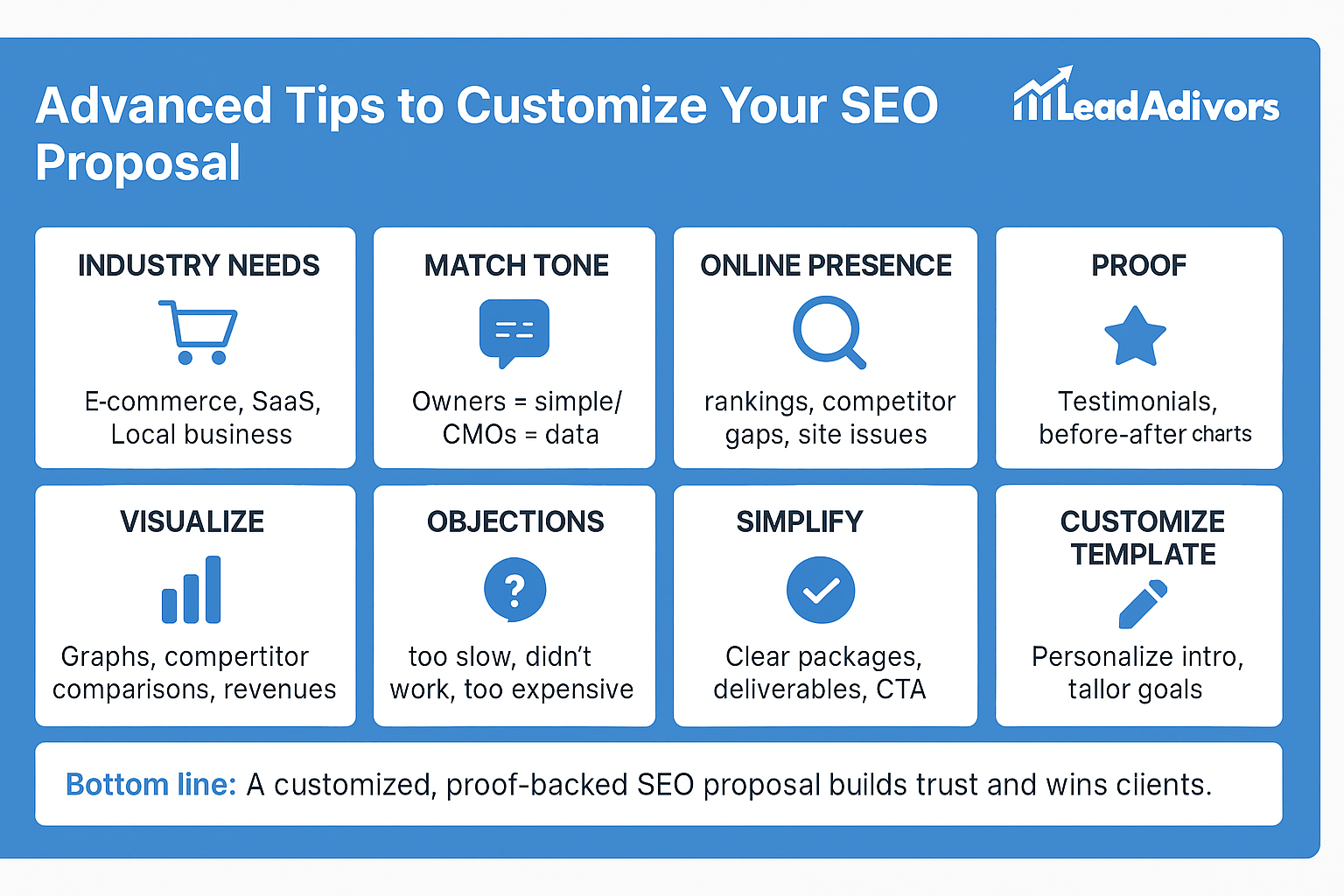
A good SEO proposal doesn’t win clients by looking fancy—it wins because it feels like it was made for them. A cookie-cutter approach rarely works. If you want to impress a potential client, your proposal should speak their language, address their concerns, and prove you’ve done the homework. Here’s how to make that happen:
1. Focus on the Client’s Industry Needs
Generic pitches are easy to spot. Demonstrate your understanding of how their industry operates.
- E-commerce: Stress on page SEO for product descriptions, site speed, and structured data. Back it up with a link-building plan that increases authority for category pages.
- SaaS: Position your SEO efforts as lead-generation machines. Show how improving rankings for high-intent keywords reduces dependency on paid ads and drives demo signups.
- Local businesses: Include a local SEO audit and point out issues like inconsistent citations or weak map pack visibility. Many business owners prioritize phone calls and foot traffic over rankings.
Example: A SaaS founder cares about cost-per-lead, while a bakery owner just wants more people walking in the door. Same SEO, different story.
2. Match the Tone to the Decision-Maker
Not everyone who reads your proposal thinks the same way. Adjust the language:
- Small business owners → Keep it simple. Focus on real-world results like “more calls,” “more website visitors,” or “more online orders.” Skip the jargon.
- CMOs and marketing managers → Go data-heavy. They’ll expect to see ROI projections, competitor benchmarks, and how your SEO project ties into their larger marketing campaigns.
Think of it this way: the CEO wants “growth,” the CMO wants “strategy,” and the marketing intern wants to know “what’s happening next week.”
3. Spotlight Their Current Online Presence
Don’t just tell them you’ll improve results—show them where they stand today.
- Provide a simple snapshot of rankings for key terms.
- Highlight traffic gaps where competitors are ahead.
- Call out obvious issues like missing meta tags or slow load speeds.
Clients love seeing a mini “before” picture because it makes your “after” projections feel more believable.
- Add Testimonials, Proof, and Case Studies
Trust is everything in SEO. A potential client may have been burned before, so showing evidence matters.
- Share quotes from previous clients in similar industries.
- Use before-and-after charts to highlight traffic growth or ranking improvements.
- Drop in recognizable brand logos (with permission) to boost credibility.
👉 Example: “We helped a local dentist triple calls in 90 days” is more powerful than “We offer local SEO.”
- Visualize the Data That Matters
Numbers are good, but visuals are better.
- Use simple graphs to show projected growth in organic search traffic.
- Add a chart comparing keyword visibility vs. their top competitor.
- Include a forecast for revenue impact tied to rankings.
Even if clients don’t know what a canonical tag is, they do understand a chart that goes up and to the right.
6. Tackle Objections Before They Ask
The strongest proposals don’t wait for questions—they answer them first.
- “SEO takes too long.” → Show early wins like metadata fixes, quick technical improvements, and small boosts in traffic.
- “We tried SEO before and it didn’t work.” → Position your SEO agencies as strategic and customized, not one-size-fits-all.
- “It’s too expensive.” → Frame pricing as an investment. Compare monthly SEO costs with what they’d spend on ads for the same exposure.
This kind of proactive approach shows confidence and builds trust.
7. Simplify the Decision-Making Process
Don’t make clients overthink—make it easy to say “yes.”
- Offer clear package options (starter, growth, enterprise).
- Outline exactly what’s included—deliverables, timelines, and outcomes.
- End with one strong call to action, like “Approve the proposal to get started next week.”
The less friction, the more likely they’ll sign
8. Customize, Even If You Use a Template
Templates save time, but they should never feel like copy-paste. A free template is just a starting point.
- Rewrite the intro to mention their industry and pain points.
- Adjust goals to their actual business size and growth stage.
- Swap in data from your research instead of generic filler text.
Clients can tell when a proposal was built in 10 minutes. A little extra personalization goes a long way.
Bottom line: A good SEO proposal is equal parts strategy and psychology. By tailoring your message, using proof, and addressing concerns upfront, you make your proposal feel like a solution—not just another sales document. That’s how you turn a skeptical reader into a paying client.
Common Mistakes That Lose Clients (And How to Avoid Them)
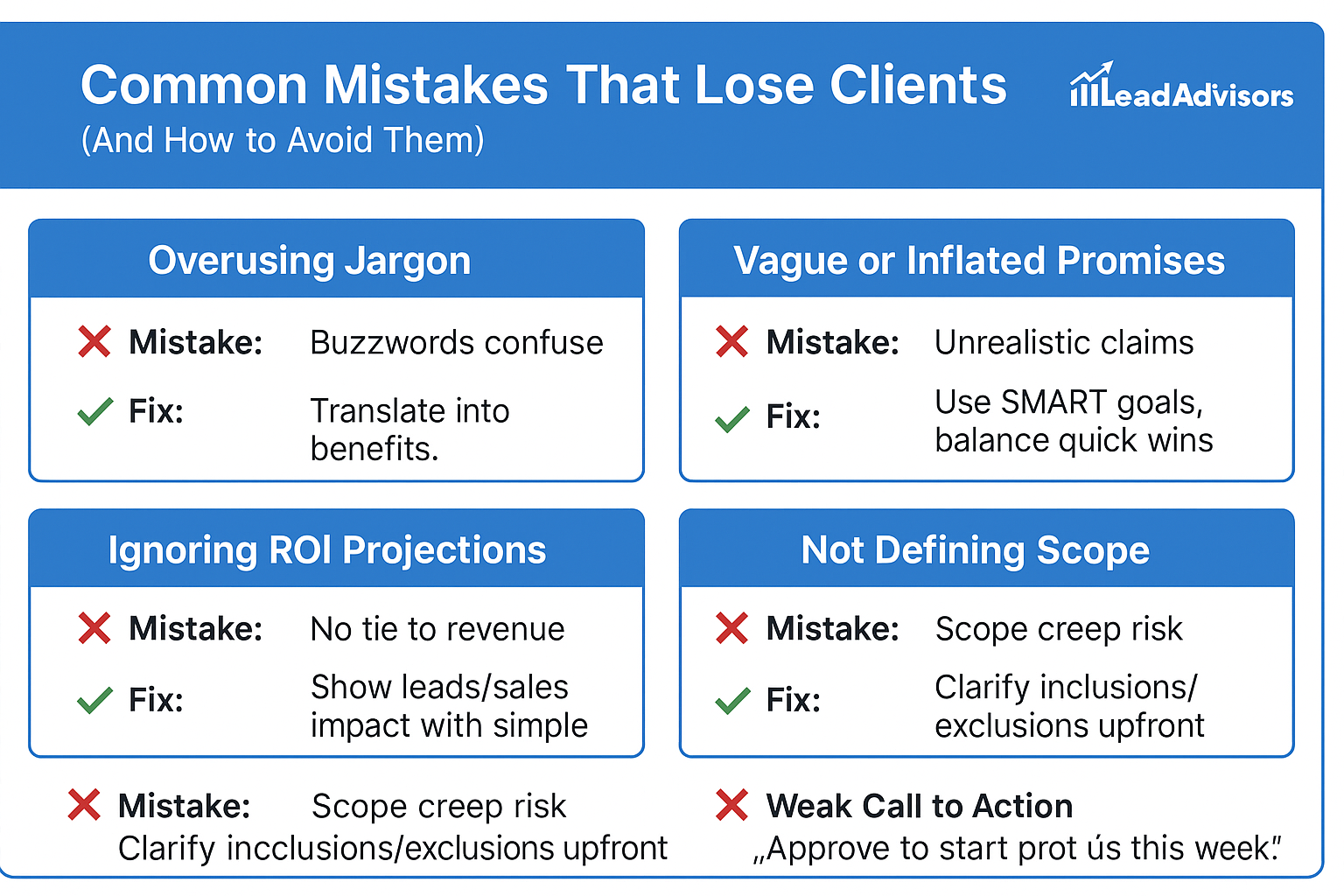
Even the strongest SEO strategy can fall flat if your proposal makes the wrong impression. Here are the top mistakes that cost agencies deals—and what to do instead.
1. Overusing Jargon
The mistake: Proposals stuffed with technical buzzwords like “canonicalization” or “crawl depth” overwhelm readers. Most potential clients aren’t SEOs—they just want to know how you’ll grow their business.
The fix: Translate technical terms into plain benefits. Instead of “we’ll fix canonical tag errors,” say “we’ll make sure search engines understand your site structure so you can rank higher.”
2. Making Vague or Inflated Promises
The mistake: Saying things like “We’ll get you to #1 on Google in 30 days” might sound exciting, but it’s unrealistic. This sets you up for disappointed clients and broken trust.
The fix: Use the SMART framework—set goals that are Specific, Measurable, Achievable, Relevant, and Time-bound. A good SEO proposal balances confidence with honesty, showing both quick wins and realistic long-term outcomes.
3. Ignoring ROI Projections
The mistake: Listing tasks without connecting them to revenue or leads. A winning SEO proposal that skips ROI leaves clients thinking, “So what does this actually do for me?”
The fix: Always tie your SEO efforts to measurable outcomes. Show how organic search traffic can translate into new leads or sales. Even simple charts or case studies from previous clients can make ROI tangible.
4. Not Defining Scope (Leading to Scope Creep)
The mistake: Writing vague statements like “We’ll handle your SEO.” Without clear boundaries, clients may expect you to cover everything—including work outside the original plan.
The fix: Spell out exactly what’s included in the SEO project (audits, on page SEO, content creation, link building) and what isn’t. Clear scope builds trust and prevents future conflicts.
5. Weak or Missing Call to Action
The mistake: Ending a proposal with “Let us know what you think” or nothing at all. This leaves the client unsure of what happens next.
The fix: Close with a confident, specific CTA. Examples:
- “Click approve to get started this week.”
- “Schedule your kickoff call here.”
- “Sign the attached agreement to secure your spot.”
Strong CTAs make it easy for clients to move forward without hesitation.
Bottom line: Avoid these five mistakes, and your proposals will immediately feel clearer, more professional, and more trustworthy. A good SEO proposal doesn’t just explain what you’ll do—it makes clients excited to take the next step.
Data & Visualization to Strengthen SEO Proposals
Numbers tell stories, but visuals sell them. Focus on traffic forecasts showing realistic growth based on industry benchmarks, competitor gap analysis highlighting missed opportunities, and keyword growth potential quantifying traffic and revenue impact.
Essential Tools: Google Looker Studio for custom dashboards, SEMrush for competitor research, and Ahrefs for backlink data. Choose 3-4 high-impact metrics instead of overwhelming clients.
Winning Visuals: Side-by-side traffic comparisons (current vs. projected), keyword opportunity heatmaps, and competitor positioning matrices. A funnel diagram showing how SEO drives leads makes ROI tangible for business-focused stakeholders.
Step-by-Step: How to Write an SEO Proposal That Converts
Step 1: Conduct a Mini SEO Audit
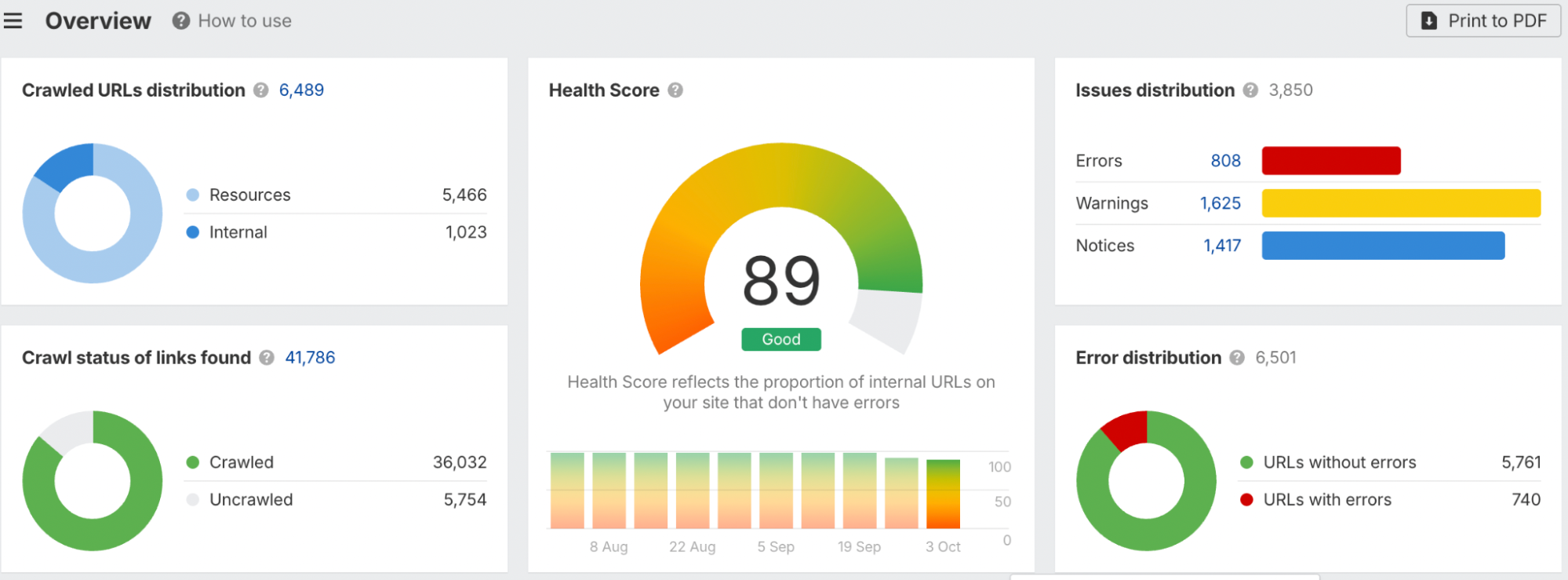
Review site architecture, analyze top pages, check backlinks, and identify technical issues. Focus on high-impact findings that create urgency—this demonstrates expertise and reveals problems that clients may not have been aware of.
Step 2: Define Client-Specific SEO Goals
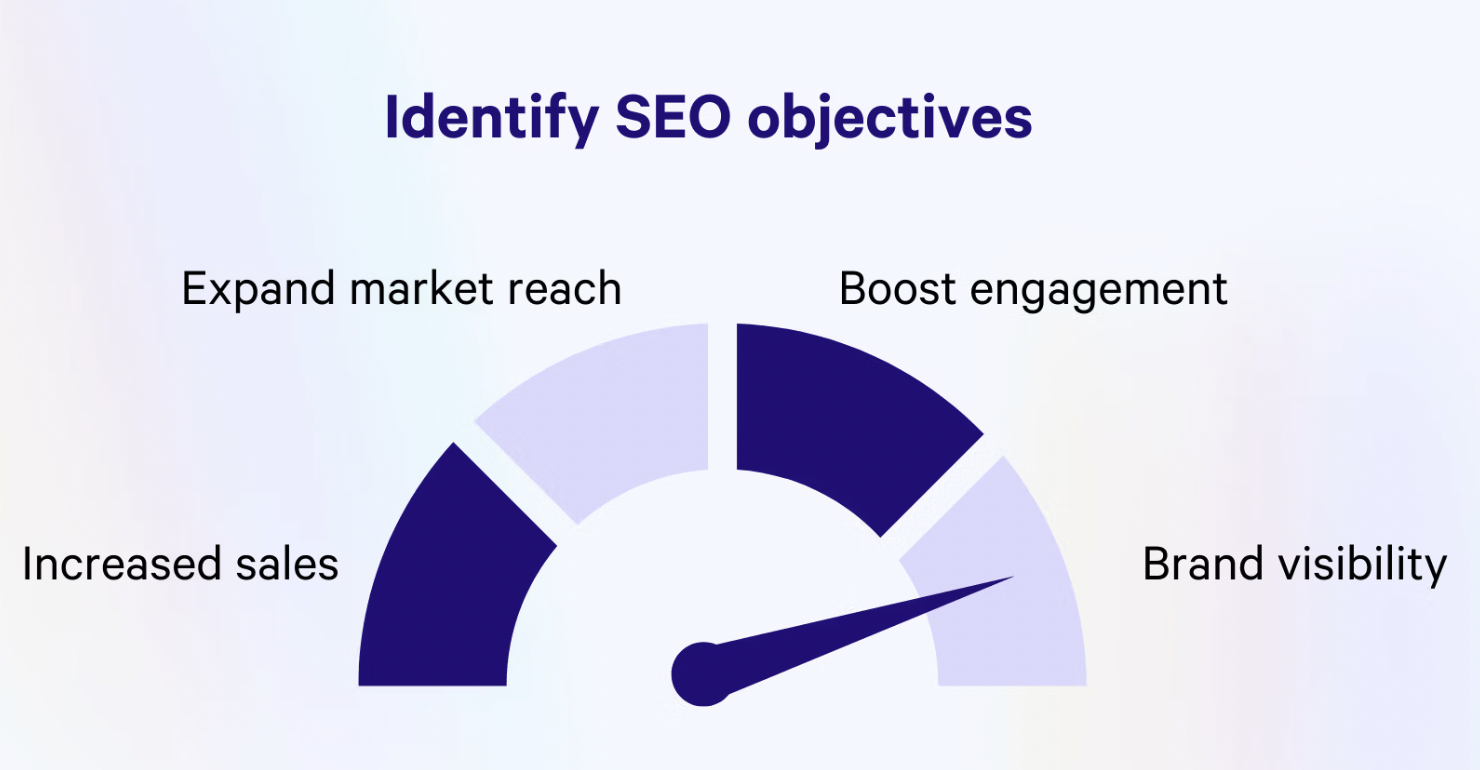
Skip generic goals. Tie objectives to business outcomes: Generate 500 qualified leads quarterly or Reduce CAC by 30% within 12 months. Interview stakeholders to understand what success means, then create measurable SEO targets with clear timelines.
Step 3: Build a Tailored SEO Strategy
Prove you understand your client’s specific seo challenges. Structure strategy into clear phases—technical foundation (months 1-2), content optimization (months 3-4), link building (months 5-6). Include on-page priorities, content roadmap aligned with customer intent, technical fixes ranked by impact, and industry-specific link acquisition tactics.
Step 4: Add Pricing & ROI Projections
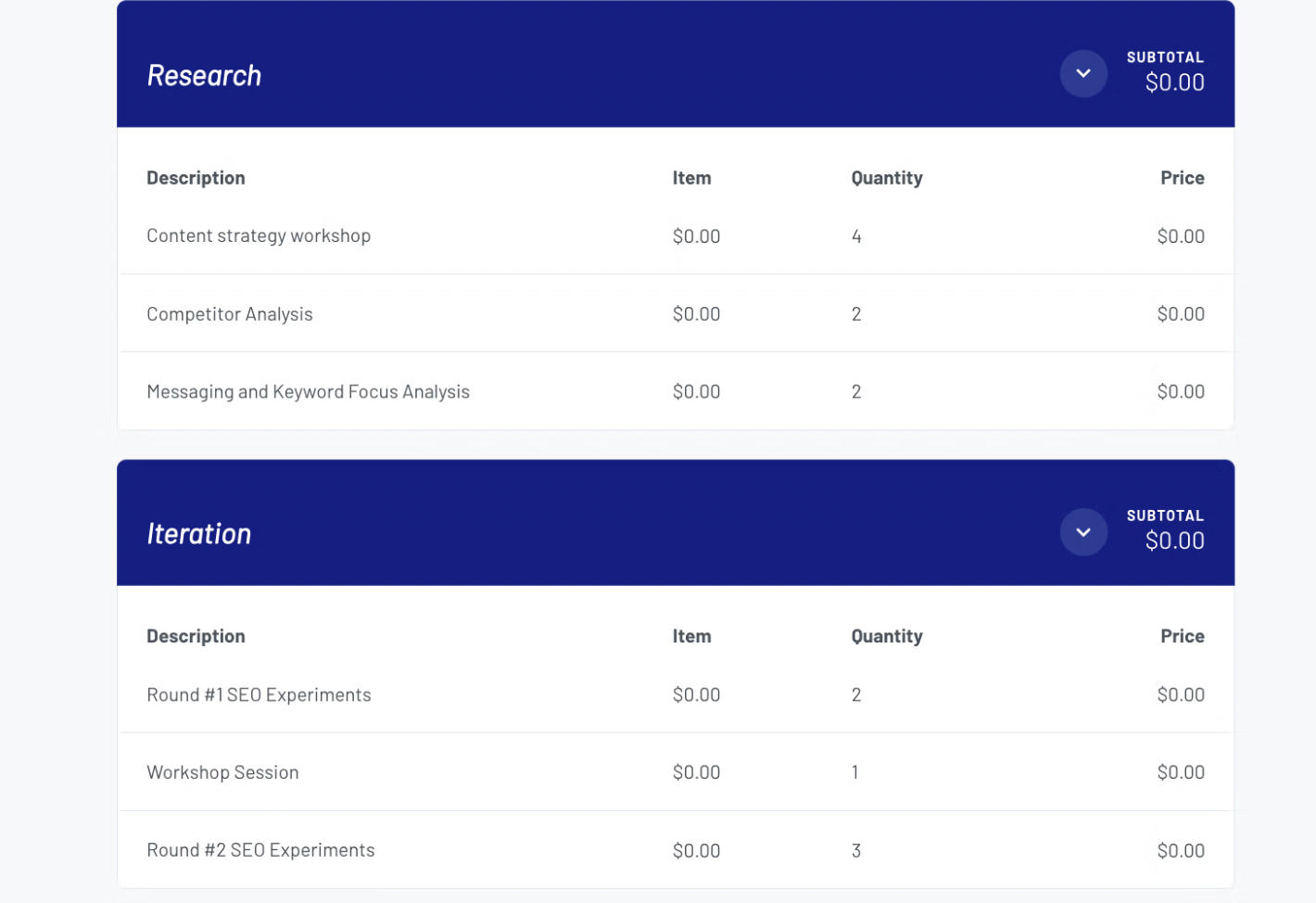
Present pricing as an investment, not a cost. Show conservative traffic projections, estimate conversion rates, and calculate revenue impact. If proposing $3,000 monthly, demonstrate potential $15,000+ additional revenue. Offer tiered packages: Essential, Growth, and Premium options.
Step 5: Include Case Studies & Proof
Feature 2-3 relevant case studies with specific metrics: Increased organic traffic by 247% for a B2B SaaS company. Include ranking improvements, traffic graphs, and client testimonials addressing both results and working relationships.
Step 6: Design a Clean, Professional Proposal
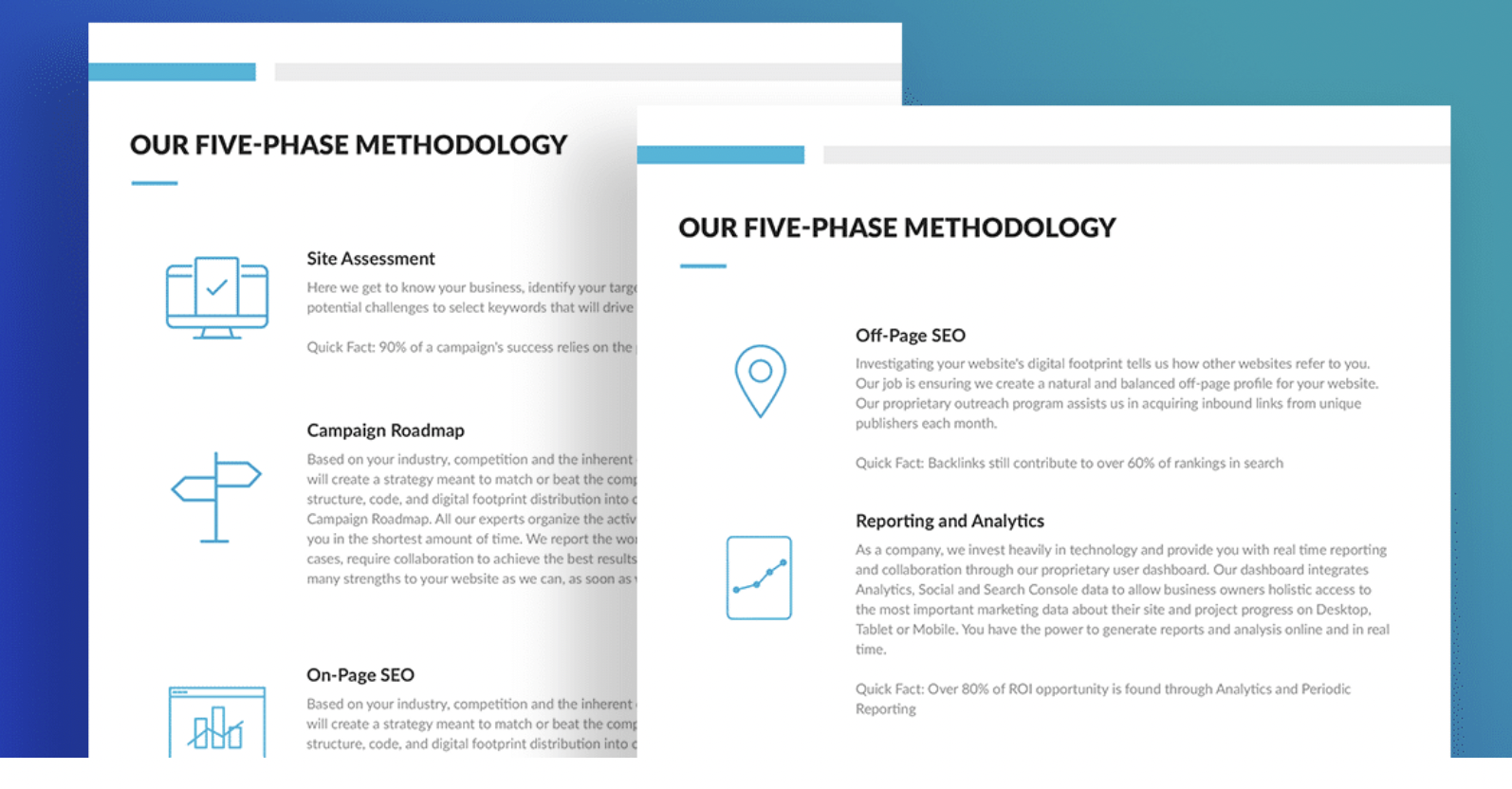
Use consistent branding, clean typography, and white space. Break text with charts and callout boxes. Number pages and include a table of contents for longer proposals. A polished document signals professionalism.
Step 7: Close With a Strong CTA
Create urgency: “Reply by [date] to lock in this quarter’s start date.” Make it easy to say yes—schedule a call, sign electronically, or reply with questions. Remove friction from decision-making.
Scaling SEO Proposals for Agencies
Automation Tools: PandaDoc for e-signatures and engagement analytics, Qwilr for visually stunning interactive proposals, and Proposify for team collaboration. Systemize repetitive parts (pricing tables, service descriptions) to invest energy in customizing strategy sections.
Proposal Library: Organize templates by industry vertical. Create modular sections that you can mix and match—such as technical audits, content strategies, and link-building approaches. Develop battle-tested language for common objections.
Tracking Performance: Monitor overall win rates and those by industry. Note which pricing structures get accepted most. If you’re losing proposals after including specific services, that’s valuable intelligence for optimization.
SEO Proposal Example (Annotated Walkthrough)
Executive Summary
“Your site ranks for 234 keywords, but competitors dominate 1,400+ high-intent terms. This 6-month strategy captures that $450K annual search opportunity.”
✓ Establishes stakes with competitor context and revenue potential immediately.
Current Situation
| Metric | Your Site | Top Competitor | Gap |
| Domain Authority | 28 | 52 | -24 |
| Ranking Keywords | 234 | 3,891 | -3,657 |
| Monthly Traffic | 2,100 | 45,000 | -42,900 |
✓ Visual comparison makes competitive gaps impossible to ignore.
Strategy Overview
“Phase 1 (Months 1-2): Technical Foundation – Fix crawl errors, optimize speed, implement schema. Expected: 15-20% crawlability improvement.”
✓ Each phase includes deliverables and measurable outcomes.
Investment & Returns
Monthly retainer with conservative projections showing 180% ROI by month 12.
✓ Positions cost as investment and addresses “is this worth it?” proactively.
Frequently Asked Question
What's the best format for an SEO proposal?
Should you charge for SEO proposals?
How detailed should the strategy section be?
What tools create SEO proposals quickly?
How do you adapt proposals for different budgets?
Conclusion
Strong SEO proposals prioritize clarity, relevance, and ROI in terms prospects care about. Lead with data that creates urgency, structure strategies that feel tailored, and present pricing as investment. Whether you’re solo or agency-sized, this framework makes you look professional and credible.
The difference between proposals that get filed and proposals that get signed? Making prospects believe you understand their specific challenges and have a concrete plan to solve them.
Ready to create proposals that convert? Download our free template and start winning more SEO clients—or schedule a 15-minute consultation to optimize your proposal process.



